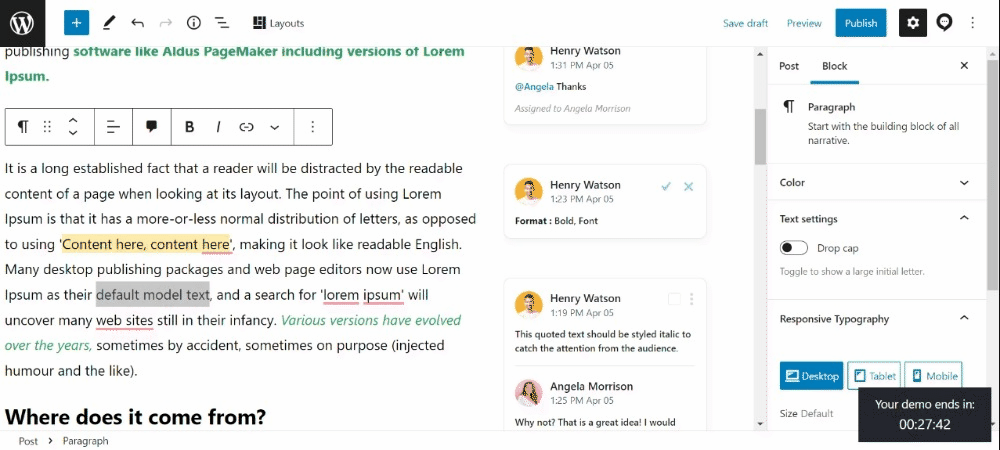Table of Contents
Content approval workflows help you produce content that your audience finds useful and achieves your business goals. To create one, you need to consider factors such as your objectives from an article, available resources, and long-term business goals.
While adopting and implementing a good workflow can boost the ROI of your content marketing efforts, using an unsuitable one might have drastic consequences:
- Spending more time and effort than necessary to produce content
- Producing content of sub-optimal quality
- Relaying your brand’s values and product features incorrectly
- Attracting the wrong audience or losing existing customers
In this article, you’ll learn how you can create a WordPress content approval workflow from scratch in four easy steps so you can produce the right content for the right people.
1. Define the purpose of your content approval workflow
In a broader sense, your content approval workflow process checks your content to ensure its relevance to your business goals. However, its exact objectives can be more than that. For instance, your content approval process might also incorporate your content editorial and review process.
Hence, the first step in creating a customized WordPress content approval workflow is to define its tangible goals. This will help you get your team on the same page and build your own content approval process.
Additionally, defining the goals is crucial for measuring the efficiency of this process and identifying any roadblocks and bottlenecks you might encounter.
For defining your goals, you need to discuss with your team to learn what your content production process needs. Is it more quality control? Is it a technical review? In other words, you need to know what improvements your content pieces need.
2. Start with a basic and linear workflow
A simple WordPress content approval workflow process has the following three steps:
- Technical review (word count, content structure, tone of voice, etc.)
- Qualitative review (topics addressed, readability, uniqueness, etc.)
- Decision (if the draft is rejected, it goes back to the author and the process repeats again)
A basic workflow is easy to understand and implement, even when most of the team members are new. It will also help you understand your specific requirements, and as it is a simple workflow, you can modify it quickly as well.
While working with a simple WordPress content approval workflow, it is vital to communicate with every team member to ensure that they are correctly using it and also to gather their feedback to improve this process.
The aim of this step is to build a process that will help you achieve the purpose of your content approval workflow process, which you have defined in the previous step.
3. Improve the workflow with your team
In this step, you start to make your content approval workflow efficient. Using the process collaboratively will help you find and fix bottlenecks and areas of improvement quickly to improve your content quality and/or save your resources such as time and effort.
To complete this step, it is crucial that your team members understand their roles and responsibilities in terms of the deliverables because it will make communication easier. You can also get feedback from external stakeholders on how the quality of the content at the end of this process can be improved while keeping the workflow efficient.
Although content team managers must keep an open mind while receiving suggestions from internal team members and external stakeholders, they should not outsource the decision-making process.
To rank the suggestions appropriately and implement the ones with the highest impact, you need to measure how well your content approval workflow is working, which brings us to the final step.
4. Measure the efficiency of your content approval workflow
Here you need to track key performance indicators (KPIs) to tangibly evaluate the efficiency of your workflow. Although every team needs to focus on a different set of metrics, here are a few to get you started:
- Approval time: The time required for a content piece to go from the “drafted” stage to the “ready to be published” stage.
- The number of revisions: This is the number of times a content piece goes through your WordPress content approval workflow process before it is cleared for publication.
- Time per revision: You can calculate it by dividing the approval time by the number of revisions.
- Stakeholder satisfaction: You can measure it quantitatively by asking your stakeholders to rate the approved draft on a numbered scale. Also, assess it qualitatively based on the rework request by the stakeholders.
You can make the list of KPIs longer by adding content performance metrics such as dwell time, signups from that page, and organic traffic.
All the above metrics will help you identify areas of improvement within your content production and approval processes.
Summing up
A well-defined and efficient content approval workflow is crucial for producing high-quality content that meets your business objectives. Building a customized WordPress content approval workflow can help you achieve this and ensure that your team is on the same page.
You can follow these four steps to create a dynamic content approval workflow:
- Define and assign a purpose to your content approval process and set the right expectations
- Start with a basic workflow that you and your team can easily implement and modify
- Improve the workflow slowly by taking feedback from your team members and stakeholders
- Track qualitative and quantitative metrics to measure the efficiency of your content approval workflow
Build an efficient WordPress content approval workflow today
One of the crucial ingredients to make your WordPress content approval process better is by ensuring good collaboration among the team members and external stakeholders.
However, it can be challenging for WordPress teams to maintain that as their approval takes place in multiple places such as team messaging apps, third-party document collaboration tools (Google Docs, etc.), emails, and video conferencing tools.
Multicollab, a WordPress collaboration plugin, eliminates the need for multiple content approval tools by enabling Google Docs-style editorial commenting on the Gutenberg Editor.

This allows everyone including your team members and stakeholders to collaborate and exchange feedback on all types of content, including videos and dynamic content blocks (like image carousels and CTA blocks).
Try Multicollab, today!
FAQs:
A content approval workflow is a systematic process that ensures that all digital content, such as blog posts, social media updates, or videos, goes through a review and approval process before being published.
Content approval is a process that ensures that the content aligns with the organization’s brand voice, values, and goals and that it is free of errors, mistakes, or inaccuracies.
A digital content approval process is a formalized system that outlines the steps involved in reviewing and approving digital content. It ensures that the final content is aligned with the organization’s objectives and effectively communicates the intended message.
Creation, review, revision, evaluation, approval, and publication are the six steps involved in the content approval workflow process.
The role of a content reviewer is to review the digital content for accuracy, quality, tone, and relevance to the target audience. They may also provide feedback to the content creator to improve the quality and effectiveness of the content.






